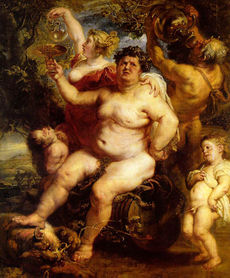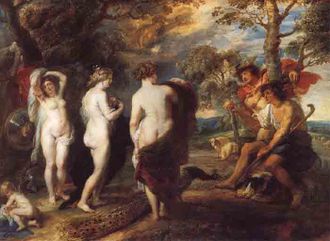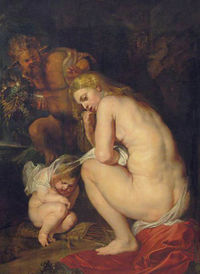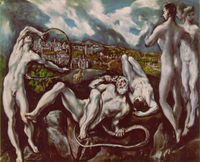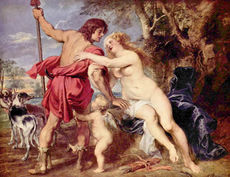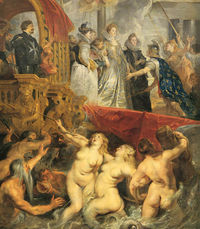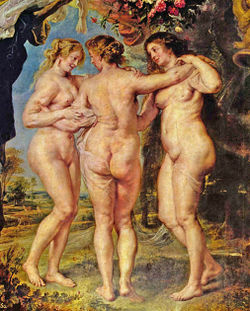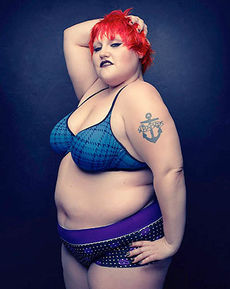Peter Paul Rubens
“I need cake before I start.”
– Peter Paul Rubens
“I am a well rounded artist. ”
– Peter Paul Rubens
“Next one to call me 'Rubensesque' gets a thumping”
– Beth Ditto
Peter Paul Rubens (28 June 1577 – 30 May 1640) is the Belgian-by-adoption-born artist famous for painting a lot of very fat people in 17th century Europe. You think obesity is a modern problem? Then go along to the great art collections in Britain's National Gallery or the Louvre in Paris. Rubens's lardy monsters dominate many rooms, quivering masses of blancmange-coloured skin greet the eye and then you check the caption: Judgement of Paris. Eh? You what?? Goddamit, it's enough to want you to go on a diet.
Flanders' Fleshy Wonders[edit | edit source]
Now there is nothing wrong about painting a lot of fleshy people. The late artist Lucien Freud was always doing it, and painting himself nude in the bargain. Luckily for us, Rubens' is said kept his own clothes on except for one early painting (see above). Was Rubens making a point at time when his contemporaries were happy to paint people with perfect bodies that wouldn't have shamed the pages of a fake naturist website? It's an interesting question but you are on the wrong website for an answer.
Rubens was born in Seigen in the Holy Roman Empire in 1577. His father Jan was a Calvinist womaniser (a complicated combination) from Flanders, even more so when he seduced the wife of William the Silent whilst working for the future leader of Holland. Peter's mother Maria Pypelinckx got Jans out of the clink but when Jan died not long after, Marie moved to Antwerp with her family to stop Germans making further fun of her name.
The future artist grew up at a time when the Dutch broke away from the Belgians because they regarded the latter as idle, chocolate stuffing Catholics who preferred to have their bums wiped by their Spanish imperial overlords instead of going it alone. At least that is one possible theory and indeed the Dutch did go in for the Protestant Work-Out ethic which emphasised lean, mean bodies covered from hat to black patent leather shoe . The other theory is that Rubens just liked fat people because it's likely he was a bit of an over-egged pudding himself.
Considering the religious preferences of his father, Peter became an aggressive supporter of the Catholic Counter Reformation which was then all the rage. This lead to him becoming an exchange student and he moved to Rome to inhale as much incense smoke as he could manage. Whilst there Rubens picked up a paint brush and in a rapid career advancement, he moved applying whitewash to outdoor privies to the inside of a church within a ten years. It's around this time that the young Rubens began to develop his fascination with gut buckets. Art historians call this time period the 'Baroque Style' where over doing it artistically was encouraged in Catholic Europe. Rubens became a keen supporter.
Turn of the 17th Century Art Scene[edit | edit source]
To be honest to Rubens, he wasn't the only artist to start painting fat people. Italian artists like Caravaggio were slipping in a few porkers now and again on their larger canvases. Rubens just took it--the blimposis fetish--a little...no..a looooot further. It wasn't as if he couldn't sketch leaner when asked to at the drop of a plumed hat but the inescapable conclusion is that 'Tubby Rubby' just loved to splash it all on when it came to paint. The fatter the better. Found his niche, showed no signs of wanting to slacken this particular appetite, lived happily ever after even if some of his models got neuropathy.
Now the unusual thing is that Rubens found a ready market for his blubbery nudes. It was more than just a passing fad. Under Rubens' paint brush, a canvas would fill of plump children, pot bellied men but especially acres and acres of fat women. Even the animals were painted as if they had been on a 24 hour swill in the trough. What was going on in Europe and the Europeans at this time? Indeed, even the mania for fatties spread north into the Protestant countries. One of Ruben's later students was that old Dutch misery face Rembrandt whose self portraits stare out at us as a study in bad food. Since we know other artists of the time were still painting perky, perfect nudes in the fashion of Titian or string beans like El Greco, then there has to be another explanation. Was there a seventeenth century version of McDonalds nearby?
According to Ruben's star pupil, Antony 'Tony' Van Dyke the answer was that Rubens knew where to find his size 20 models in down town Antwerp. Van Dyke (ancestor of all the other Van Dykes now in exile in America or living in San Francisco) left one of his notebooks behind on an Ostend horse drawn tram. In translation by Dick Van Google it reads:-
It's like this Marie-Poppins. Super calories are absolutely quite atrocious..if you want to be slimmer than a Chim Chim Cher-ee Chimney, You have got to fry the birds, fly high as a kite and live off a spoon full of sugar until the main course goes down.
I Love Your Ladies[edit | edit source]
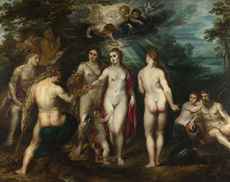
In 1619 Rubens eventually chose to write down his thoughts about why he liked 'fat painting' with his best selling book 'The Rubens Diet'. It famously outlined all the good reasons why food was good for you and that slimming was for Famine Freaks and others such like the Protestants with their obsession that God punished sinners by making their tummies spill over their breeches.
By now Rubens 'Big Baroque' had finally gained him the attention of some important Royal clients. They liked the artist's style but asked for some old fashioned nudes for their bathroom suites. So Rubens painted 'slim' and 'generous' versions of a number of works. For example, he did another version of the Judgement of Paris but made the models so insubstantial that people refused to believe they were by him. Rubens needed to leave petit-bourgeois Belgium. He would expand his horizons and perhaps his waistline by going to Paris. He heard King Louis XIII was a notorious 'fat art lover' so Rubens moved to France.
Rubens or 'Monsieur Rubes Nudes' as the French king addressed him, commissioned Rubens to paint a series of works to celebrate his father King Henri's marriage to the Italian Princess Pudding, Marie de Medici. It seemed to be a bit of a dry and uninspiring project to get on with but Louis sent a secret note to Rubens that is said to have asked for 'loads of those big girls you paint so well Monsieur Nudes'. Rubens obliged and using Van Dyck to send any spare drawings from his 'flabby drawer', Rubens set off to work. It is believed Rubens had hoped to find suitable French models but the ones offered were built like ironing boards and wore dark glasses and smoked a lot, one of the few dirty habits the Belgian painter actively objected to.
Diplomatic Excess Baggage[edit | edit source]
King Louis was very happy with his 'les grande dames' but decided Rubens was probably a Spanish spy. Rubens therefore decided that if he was going to be treated like a spy, he would get paid for that too and joined the Spanish diplomatic service. This gave him the chance to go to Spain, the Dutch Republic and England. It was an opportune time to travel to cross the English channel. A new monarch wanted his share of the Fat Art Movement.
King Charles I had got his taste for Rubens' works whilst hunting for a bride at the Royal Spanish court in Madrid. Now he wanted some of his own and offered Rubens a fat bonus to provide his with some er 'expansive examples' to hang in his various royal palaces. Could Rubens knock out a few 'lumpy ladies' to be going on with? A few canvases later and Charles was keen to use Rubens again but others in England saw this as the thin edge of a large cake marked Roman Catholicism. The Puritans disapproved and one of their leaders Oliver Cromwell made his name in parliament castigating the King's artistic tastes. They demanded Rubens go and take his filthy work elsewhere.
As a result of this pressure, Rubens couldn't stay too long in England but was allowed to finish decorating the Banqueting Hall for the king. To the English with its overflowing examples of Rubens fatties, this foreigner was endangering the health of the country's youth. The Puritans so hated the work that when they later went to war against Charles in 1642 and won the English Civil War, it was the last work of art the king saw as he was led out onto the window ledge and had his head cut off.
Last of Rubens' Big Commissions[edit | edit source]
By now Rubens was slowing down a bit, his own excessive obesity lead him to once again to return painting the 'big ones'. It was then that Rubens finished off his master work, commonly called The Three Graces. Artists before had show them as lithe young women with fit and healthy bodies. Rubens gave them the full fat treatment and what a trio of pleasures they are if you like your women XXL size. Which he did. This is full fat cheese, baroque bottom wobbling stuff.
Now stand back and look the honesty of this painting. Who knows who these women were really? Peasant girls - unlikely: aristocrats - most not definitely. Men with fake boobs? Well....no, the answer is obvious. They were real women who Rubens had fattened up especially for his work. He had access to money and food and in those days, dying of hunger was not a pejorative term of political abuse but a real life threatening danger. Yes, there is no doubt, Rubens was the master of recipes that would really load you up in the loose hanging flesh regions. A maestro, a Chef, a baritone opera singer, Rubens was a chubby artistic chronicler.
Death[edit | edit source]
Ironically, Rubens died after his doctor suggested he lose weight. This wasn't a health issue as such, Rubens's medical quack held out no hope for recovery but was involved in the funeral business. Rubens was too fat for any of their standard sized coffins. The artist reluctantly agreed to lay off the potatoes and bread puddings but died a few weeks later.
His funeral was held in Antwerp and the artist was buried with a modest service. Before he was barely cold, critics of Rubens Fat Style were out in force and within a decade, painting big people was considered to be the height of vulgarity. Only Rembrandt carried on the Rubens tradition but when he died, the style fell out. Soon Rubens works were placed in the basements of galleries where later artists would laugh and point at Rubens' extra brushwork.
It would take until the 20th century before even considering painting fat people would become mainstream again. Today art galleries still check all their paintings with X rays and pigment tests to see if a 'fatter' version of the work they possess once boasted of extra paint layers in the past. And as for Rubens today, no doubt he would have loved this recognition. Why indeed isn't the patron Saint of a Highly Saturated Foods or selling hamburgers? But that would be too honest. Yes, you can buy a fat suit or learn sumo wrestling but Rubens had covered that base four centuries ago.
